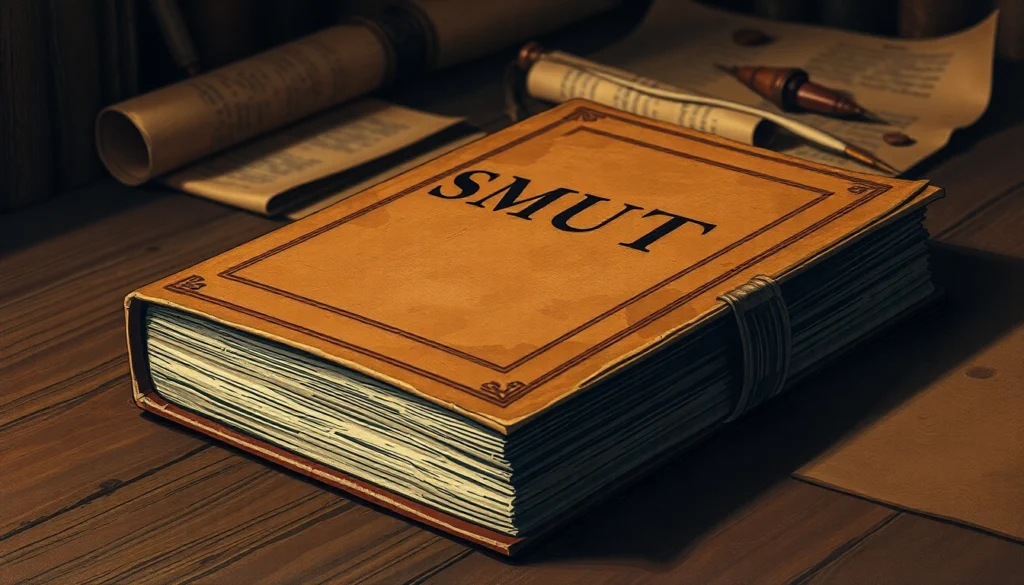Unveiling Smut: From Dirt to Taboo—A Historical and Cultural Exploration
The word smut evokes a vivid spectrum of images and ideas, primarily associated with adult media, explicit art, and literature that aim to evoke arousal. Today, it is a term that is often linked to the realm of erotic content, scandal, and societal taboos. However, its journey from an innocuous descriptor of dirt to a symbol of scandalous and adult material is a fascinating story of linguistic evolution, cultural shifts, and societal attitudes toward morality and expression. This exploration delves into the origins of the term, its transformation over centuries, notable examples in history and literature, and its ongoing cultural significance.
Introduction to the Term “Smut” and Its Modern Association with Adult Media
In contemporary usage, smut predominantly refers to media—such as movies, literature, art, and online content—that features explicit sexual material designed to incite arousal. This association has become so ingrained that the term often carries connotations of taboo, scandal, and societal boundaries being pushed or crossed. The modern understanding of smut is closely tied to the concept of adult entertainment, a sector that has grown exponentially with technological advances and changing cultural norms.
Yet, the term’s journey to this modern connotation is complex and layered. It encompasses centuries of shifting perceptions, legal battles, censorship, and cultural debates about morality, freedom of expression, and societal standards. To understand the full scope of ‘smut’, one must explore its historical roots, how its meaning has evolved, and the cultural reactions it has provoked over time.
The Historical Origins of Smut: From Dirt and Stain in the 17th Century
The Earliest Mentions and Literal Meaning
The earliest known uses of the word smut date back to the 17th century, where it was primarily used to describe dirt, stains, or soot—unsightly marks that marred surfaces or clothing. The word itself likely stems from Old English or perhaps earlier Germanic roots, with similar words found in various Germanic languages. At that time, the concept of dirt or stain held little moral or social connotations; it was simply a physical description of grime or filth.
During this period, the term was often used in everyday language to describe physical imperfections or uncleanliness. For example, a cloth stained with soot or mud was referred to as being covered in smut. This literal usage persisted for centuries and was well understood by the general populace. The word’s etymology, however, remains somewhat obscure, with some linguists speculating connections to other Germanic words meaning “to smear” or “to blacken.”
Transition into Figurative and Moral Contexts
While originally a physical descriptor, the word smut began to acquire metaphorical connotations by the 17th and 18th centuries. The idea of dirt or stain was extended metaphorically to moral and social imperfections—such as indecency, impurity, or disgrace. This shift set the stage for its later association with scandalous and obscene material, which gained prominence in the 19th century.
The Evolution of Meaning: From Dirt to Scandalous and Obscene Material in the 19th Century
From Physical Dirt to Moral Filth
By the 19th century, the word smut had broadened beyond physical dirt to encompass moral and social impurities. This transition was influenced by societal attitudes toward sexuality, morality, and propriety. As the Victorian era emphasized strict moral codes, anything deemed indecent or immoral was often described as smutty or smut-ridden.
This period saw an increasing concern with sexuality and decency, especially in literature and the arts. Works that challenged societal norms or depicted sexual themes were often labeled as smut. The term became associated with content considered scandalous, obscene, or morally corrupting.
Literary and Cultural Examples
A significant example from this era is the notorious publication of Fanny Hill (1748), officially titled Memoirs of a Woman of Pleasure. Written by John Cleland, this novel was considered highly obscene and faced censorship and legal persecution. Cleland was imprisoned, and the book was banned multiple times, yet it endured as a classic example of early erotic literature. Its explicit content and perceived moral depravity epitomized the societal fears surrounding smut as a threatening influence on virtue and morality.
Notable Historical Examples: Fanny Hill and Censorship Challenges
Fanny Hill and Its Censorship
Fanny Hill stands as a landmark in the history of smut. It was one of the first novels to vividly depict sexual exploits, challenging the boundaries of acceptability in literature. Its publication ignited debates about censorship, morality, and freedom of expression, with authorities viewing it as dangerous material that could corrupt the reader.
Throughout the 18th and 19th centuries, numerous works deemed smutty faced similar censorship efforts. Laws were enacted to suppress the publication and distribution of obscene materials, leading to the rise of underground publishing and the clandestine exchange of illicit content.
The Impact on Writers and Society
Many writers who dared to publish or even possess such material risked legal repercussions, social ostracism, or worse. Despite these dangers, the demand for erotic and explicit content persisted, fueling a clandestine culture that would eventually challenge restrictive moral standards.
The Cultural Impact of Smut and Its Role in Art, Literature, and Media
Art and Literature as Vehicles of Expression
Over the centuries, smut has played a paradoxical role in shaping culture. While often condemned and censored, it has also served as a vehicle for artistic expression and social critique. Artists and writers have used explicit content to explore human sexuality, challenge societal norms, and push the boundaries of artistic freedom.
From classical artworks depicting mythological or erotic themes to modern literature and film, explicit material has often been at the forefront of cultural innovation. It questions the limits of morality, explores human desire, and provides insight into the complexities of human nature.
Media and the Digital Age
The advent of the internet and digital technology revolutionized access to explicit content. The proliferation of online platforms, streaming services, and social media has transformed smut from a clandestine niche into a mainstream industry. This has led to ongoing debates about morality, legality, and societal impact.
Today, the boundary between acceptable and taboo is continually shifting, reflecting broader cultural changes. What was once considered scandalous or obscene is now often readily accessible and normalized, challenging traditional notions of morality and decency.
Contemporary Perspectives on Smut in Media and Society
Legal and Ethical Considerations
Modern society grapples with complex legal and ethical questions surrounding smut. Laws vary widely across countries and regions, with some jurisdictions imposing strict censorship or criminal penalties for production, distribution, or possession of explicit material, while others adopt a more liberal stance emphasizing free expression.
In many places, age restrictions, consent, and distribution regulations aim to balance individual freedoms with societal protections. Ongoing debates address issues like exploitation, consent, and the impact of explicit content on social attitudes and behaviors.
Societal Attitudes and Cultural Shifts
Public perceptions of smut continue to evolve. While some view it as a necessary outlet for human sexuality, personal freedom, and artistic expression, others perceive it as a threat to moral standards or social cohesion. The #MeToo movement and discussions about consent and exploitation have further complicated these perceptions, prompting calls for greater responsibility and accountability within the industry.
Impact on Relationships and Personal Well-Being
Research indicates that consumption of adult content can have diverse effects on individuals and relationships. Some studies suggest it may enhance sexual satisfaction or serve as a healthy outlet, while others highlight potential risks such as unrealistic expectations or dependency. As society becomes more open about sexuality, conversations about healthy consumption and ethical production are gaining prominence.
Conclusion: The Changing Boundaries of Morality and Expression
The journey of smut from dirt and stain to a symbol of adult media reflects broader cultural shifts in morality, censorship, and freedom of expression. What was once considered scandalous or morally corrupting has gradually become an integral part of modern media and art, challenging society to reconsider its boundaries of acceptability.
Throughout history, the tension between societal norms and individual desires has propelled the evolution of smut. Today, it occupies a complex space—simultaneously a source of controversy, artistic exploration, and personal freedom. As cultural attitudes continue to shift, the boundaries of morality and expression will likely remain fluid, highlighting the enduring human fascination with sexuality and the desire to explore it openly and honestly.
In understanding the history and cultural significance of smut, we gain insight into the evolving nature of societal taboos and the persistent drive for expression. It reminds us that what is considered acceptable today may be challenged tomorrow, and that the exploration of human sexuality remains an integral part of our collective story.


